Reinventing the Record: Strange New Formats of the Digital Age | reviews, news & interviews
Reinventing the Record: Strange New Formats of the Digital Age
Reinventing the Record: Strange New Formats of the Digital Age
The artists who are fighting the idea of digital music as ephemera

While rumours of the album's demise may well have been premature, the digital age certainly does present increasing challenges when it comes to getting punters to keep and treasure music. Of course, really it all went wrong with the CD: those irritating plastic cases with hinges and catches guaranteed to snap off and get hoovered up, the booklets you have to squint to read, the discs that slide under car seats or behind radiators.
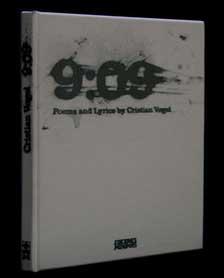 But as the flow of available music becomes ever more overwhelming, the need to stand out becomes more urgent for labels and artists. So it is that the diversity of ways music can reach us keeps expanding as they try to create something we'll want to keep. When I interviewed the techno musician Cristian Vogel last year, he had just released a large selection of MP3s on a disc mounted inside a hand-silkscreened book of poems (pictured right), and spoke of the idea that musicians with niche appeal might increasingly release in ultra-limited runs directly to collectors in the same way contemporary artists do. Whether this ever proves to be economically viable or not, we are certainly in a period where the digitisation of music, far from disembodying it, seems to make the carrying object more and more important, in certain quarters at least – and presented here are a few of the more conceptually interesting objects to arrive in the last couple of months.
But as the flow of available music becomes ever more overwhelming, the need to stand out becomes more urgent for labels and artists. So it is that the diversity of ways music can reach us keeps expanding as they try to create something we'll want to keep. When I interviewed the techno musician Cristian Vogel last year, he had just released a large selection of MP3s on a disc mounted inside a hand-silkscreened book of poems (pictured right), and spoke of the idea that musicians with niche appeal might increasingly release in ultra-limited runs directly to collectors in the same way contemporary artists do. Whether this ever proves to be economically viable or not, we are certainly in a period where the digitisation of music, far from disembodying it, seems to make the carrying object more and more important, in certain quarters at least – and presented here are a few of the more conceptually interesting objects to arrive in the last couple of months.
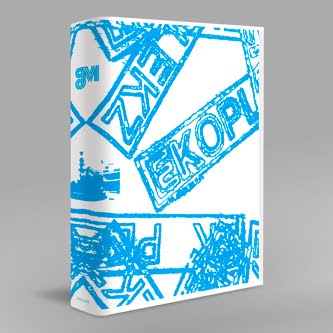 The cassette has become the archaic technology of choice for whole scenes. While vinyl has clung on to a life of its own thanks to club DJs, the cassette seemed almost entirely obsolete until it was gradually resurrected over the 2000s by noise and indie musicians as symbolic of the early home-industry days of the post-punk independent sector, the pre-digital fallibility of its recordings speaking of the decaying memories of the past. It has become visually iconic for many, too, as symbolic of the days of the homemade “mixtape”. One artist recently has perfectly tapped into the iconography of the cassette: Bristol's electronic dub producer Ekoplekz has a sound which is based on car-boot-sale-acquired technology, and which despite modern twists looks definitely back to the electronic experimentation of the late 1970s and early 1980s, so his beautifully printed double-cassette pack Memowrekz (pictured left), with its title a multilayered pun on the Memorex brand, is a great expression of that.
The cassette has become the archaic technology of choice for whole scenes. While vinyl has clung on to a life of its own thanks to club DJs, the cassette seemed almost entirely obsolete until it was gradually resurrected over the 2000s by noise and indie musicians as symbolic of the early home-industry days of the post-punk independent sector, the pre-digital fallibility of its recordings speaking of the decaying memories of the past. It has become visually iconic for many, too, as symbolic of the days of the homemade “mixtape”. One artist recently has perfectly tapped into the iconography of the cassette: Bristol's electronic dub producer Ekoplekz has a sound which is based on car-boot-sale-acquired technology, and which despite modern twists looks definitely back to the electronic experimentation of the late 1970s and early 1980s, so his beautifully printed double-cassette pack Memowrekz (pictured left), with its title a multilayered pun on the Memorex brand, is a great expression of that.
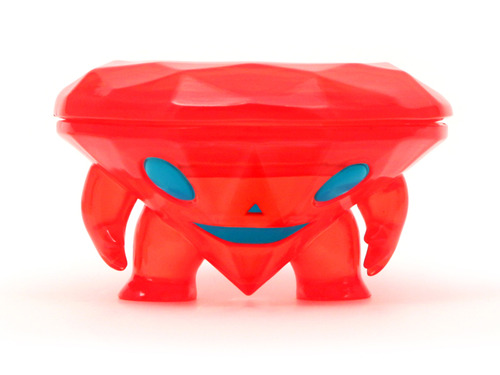 An almost completely opposite approach is taken by the eccentric Norwegian alt-pop act Datarock. Their dramatic songs also look back to the 1980s – but to the satirical electro-rock of Talking Heads and Devo, and rather than embracing archaic technology, they emphasise the high-gloss aspirationalism of that era. Thus they have just released “Catcher in the Rye” as “the most extravagant single in history” (pictured right), embracing the possibilities of 21st-century tech to embed 113 bonus tracks, 1500 photos, 20 music videos, and a 60-minute concert film in a USB device contained in a translucent soft vinyl toy. The band have always delivered heartfelt drama, even when their song structures are derivative, and this lavish packaging feels entirely of a piece with their unique style.
An almost completely opposite approach is taken by the eccentric Norwegian alt-pop act Datarock. Their dramatic songs also look back to the 1980s – but to the satirical electro-rock of Talking Heads and Devo, and rather than embracing archaic technology, they emphasise the high-gloss aspirationalism of that era. Thus they have just released “Catcher in the Rye” as “the most extravagant single in history” (pictured right), embracing the possibilities of 21st-century tech to embed 113 bonus tracks, 1500 photos, 20 music videos, and a 60-minute concert film in a USB device contained in a translucent soft vinyl toy. The band have always delivered heartfelt drama, even when their song structures are derivative, and this lavish packaging feels entirely of a piece with their unique style.
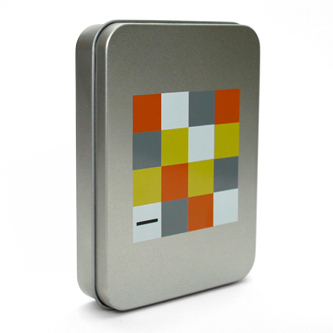 A rather more focused high-tech satire is contained in the strange, sparse techno collection An Audience With Hans Tanza. The pseudonymous techno producer is obsessed with the strangeness of office environments, and has created a fictional company Tanza Consulting to deliver a set of abstracted and unsettling PowerPoint presentations which are contained on the USB stick of An Audience... along with the seven tracks of haunting electronic rhythm. The banality of working life may seem an easy target, but this takes a fascinatingly ambiguous approach to the corporate world and the consistency of the entire package, from the minimalist geometries of the metal tin to the sparse file titles, makes the whole thing a compelling complete artwork far more than simply superfluous packaging for some pieces of music.
A rather more focused high-tech satire is contained in the strange, sparse techno collection An Audience With Hans Tanza. The pseudonymous techno producer is obsessed with the strangeness of office environments, and has created a fictional company Tanza Consulting to deliver a set of abstracted and unsettling PowerPoint presentations which are contained on the USB stick of An Audience... along with the seven tracks of haunting electronic rhythm. The banality of working life may seem an easy target, but this takes a fascinatingly ambiguous approach to the corporate world and the consistency of the entire package, from the minimalist geometries of the metal tin to the sparse file titles, makes the whole thing a compelling complete artwork far more than simply superfluous packaging for some pieces of music.
Watch "An Introduction to Tanza Consulting"
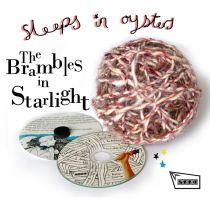 Very different but similiarly coherent in its aesthetic is the gorgeous The Brambles in Starlight mini-album (pictured right) by Sleeps in Oysters. “Homespun” is an overused adjective for quirky or idiosyncratic sounds, but in this case it perfectly suits the band's ultra-psychedelic and introspective folky electronic songs, which they have released on an edition of 150 dinky 3” CDs wrapped in entire balls of wool hand-spun from raw fleece by the duo themselves. Their full-length album Lo is no less elaborately put together, giving purchasers a choice of buying the CD with hand-illustrated insert or animal mask and embroidery kit. There are plenty of dilettante artists doing this sort of thing and coming over as nothing but horrendously twee – but with a project like Sleeps in Oysters, the absolute dedication to expressing something fundamental to them through every aspect of the package shines through. It's neither archaic nor futuristic, but expressive of something highly individualistic that feels a little outside of the normal flow of time.
Very different but similiarly coherent in its aesthetic is the gorgeous The Brambles in Starlight mini-album (pictured right) by Sleeps in Oysters. “Homespun” is an overused adjective for quirky or idiosyncratic sounds, but in this case it perfectly suits the band's ultra-psychedelic and introspective folky electronic songs, which they have released on an edition of 150 dinky 3” CDs wrapped in entire balls of wool hand-spun from raw fleece by the duo themselves. Their full-length album Lo is no less elaborately put together, giving purchasers a choice of buying the CD with hand-illustrated insert or animal mask and embroidery kit. There are plenty of dilettante artists doing this sort of thing and coming over as nothing but horrendously twee – but with a project like Sleeps in Oysters, the absolute dedication to expressing something fundamental to them through every aspect of the package shines through. It's neither archaic nor futuristic, but expressive of something highly individualistic that feels a little outside of the normal flow of time.
 It's unlikely any of these in themselves represent dramatically new ways that music will be consumed in the future. Other experiments like the Playbutton, in which one album is stored in a mini MP3 player inside a badge, likewise aim to bring back the idea of the release as a standalone object which will be collected and treasured – but thus far the simple economics of producing something like this make it unlikely to be more than a novelty or promotional item... at least until the Chinese learn to bootleg them in vast quantities. There are pro-digital evangelists, too, who question the environmental wisdom of elaborate devices like this. Maybe all these artefacts are just ephemera too, and create unecessary cultural clutter to boot. The fact remains, though, that people do like to own things, and just as importantly artists will always like to feel they are creating something that will last rather than just beaming fleeting signals into the endless chatter of the net (although almost all of this music is available purely digitally too, allowing for multiple layers of engagement). And the act of buying and displaying one of these objects is intrinsically more of a commitment than a simple click-and-download, a more direct and perhaps more satisfying relationship between artist and musician – so it does seem very likely that we will be seeing more and more releases-as-artworks like the ones here in future.
It's unlikely any of these in themselves represent dramatically new ways that music will be consumed in the future. Other experiments like the Playbutton, in which one album is stored in a mini MP3 player inside a badge, likewise aim to bring back the idea of the release as a standalone object which will be collected and treasured – but thus far the simple economics of producing something like this make it unlikely to be more than a novelty or promotional item... at least until the Chinese learn to bootleg them in vast quantities. There are pro-digital evangelists, too, who question the environmental wisdom of elaborate devices like this. Maybe all these artefacts are just ephemera too, and create unecessary cultural clutter to boot. The fact remains, though, that people do like to own things, and just as importantly artists will always like to feel they are creating something that will last rather than just beaming fleeting signals into the endless chatter of the net (although almost all of this music is available purely digitally too, allowing for multiple layers of engagement). And the act of buying and displaying one of these objects is intrinsically more of a commitment than a simple click-and-download, a more direct and perhaps more satisfying relationship between artist and musician – so it does seem very likely that we will be seeing more and more releases-as-artworks like the ones here in future.
- Find Cristian Vogel's 9:09 on Ediciones Minimas
- Download Ekoplekz's Memowrekz on Boomkat
- Find Datarock's "Catcher in the Rye" on Super 7 Toys
- Find An Audience With Hanz Tanza on Dramatic Records
- Find Sleeps in Oysters's The Brambles in Starlight on Seed Records
- Playbutton website
Share this article
Add comment
The future of Arts Journalism
You can stop theartsdesk.com closing!
We urgently need financing to survive. Our fundraising drive has thus far raised £49,000 but we need to reach £100,000 or we will be forced to close. Please contribute here: https://gofund.me/c3f6033d
And if you can forward this information to anyone who might assist, we’d be grateful.

Subscribe to theartsdesk.com
Thank you for continuing to read our work on theartsdesk.com. For unlimited access to every article in its entirety, including our archive of more than 15,000 pieces, we're asking for £5 per month or £40 per year. We feel it's a very good deal, and hope you do too.
To take a subscription now simply click here.
And if you're looking for that extra gift for a friend or family member, why not treat them to a theartsdesk.com gift subscription?
more New music
 Music Reissues Weekly: Sly and the Family Stone - The First Family: Live At Winchester Cathedral 1967
Must-have, first-ever release of the earliest document of the legendary soul outfit
Music Reissues Weekly: Sly and the Family Stone - The First Family: Live At Winchester Cathedral 1967
Must-have, first-ever release of the earliest document of the legendary soul outfit
 Album: Robert Plant - Saving Grace
Mellow delight from former Zep lead
Album: Robert Plant - Saving Grace
Mellow delight from former Zep lead
 Brìghde Chaimbeul, Round Chapel review - enchantment in East London
Inscrutable purveyor of experimental Celtic music summons creepiness and intensity
Brìghde Chaimbeul, Round Chapel review - enchantment in East London
Inscrutable purveyor of experimental Celtic music summons creepiness and intensity
 First Person: Musician ALA.NI on how thoughts of empire and reparation influenced a song
She usually sings about affairs of the heart - 'TIEF' is different, explains the star
First Person: Musician ALA.NI on how thoughts of empire and reparation influenced a song
She usually sings about affairs of the heart - 'TIEF' is different, explains the star
 Album: NewDad - Altar
The hard-gigging trio yearns for old Ireland – and blasts music biz exploitation
Album: NewDad - Altar
The hard-gigging trio yearns for old Ireland – and blasts music biz exploitation
 Album: The Divine Comedy - Rainy Sunday Afternoon
Neil Hannon takes stock, and the result will certainly keep his existing crowd happy
Album: The Divine Comedy - Rainy Sunday Afternoon
Neil Hannon takes stock, and the result will certainly keep his existing crowd happy
 Music Reissues Weekly: Robyn - Robyn 20th-Anniversary Edition
Landmark Swedish pop album hits shops one more time
Music Reissues Weekly: Robyn - Robyn 20th-Anniversary Edition
Landmark Swedish pop album hits shops one more time
 Album: Twenty One Pilots - Breach
Ohio mainstream superstar duo wrap up their 10 year narrative
Album: Twenty One Pilots - Breach
Ohio mainstream superstar duo wrap up their 10 year narrative
 Album: Ed Sheeran - Play
A mound of ear displeasure to add to the global superstar's already gigantic stockpile
Album: Ed Sheeran - Play
A mound of ear displeasure to add to the global superstar's already gigantic stockpile
 Album: Motion City Soundtrack - The Same Old Wasted Wonderful World
A solid return for the emo veterans
Album: Motion City Soundtrack - The Same Old Wasted Wonderful World
A solid return for the emo veterans
 Album: Baxter Dury - Allbarone
The don diversifies into disco
Album: Baxter Dury - Allbarone
The don diversifies into disco
 Album: Yasmine Hamdan - I Remember I Forget بنسى وبتذكر
Paris-based Lebanese electronica stylist reacts to current-day world affairs
Album: Yasmine Hamdan - I Remember I Forget بنسى وبتذكر
Paris-based Lebanese electronica stylist reacts to current-day world affairs

Comments
...
...